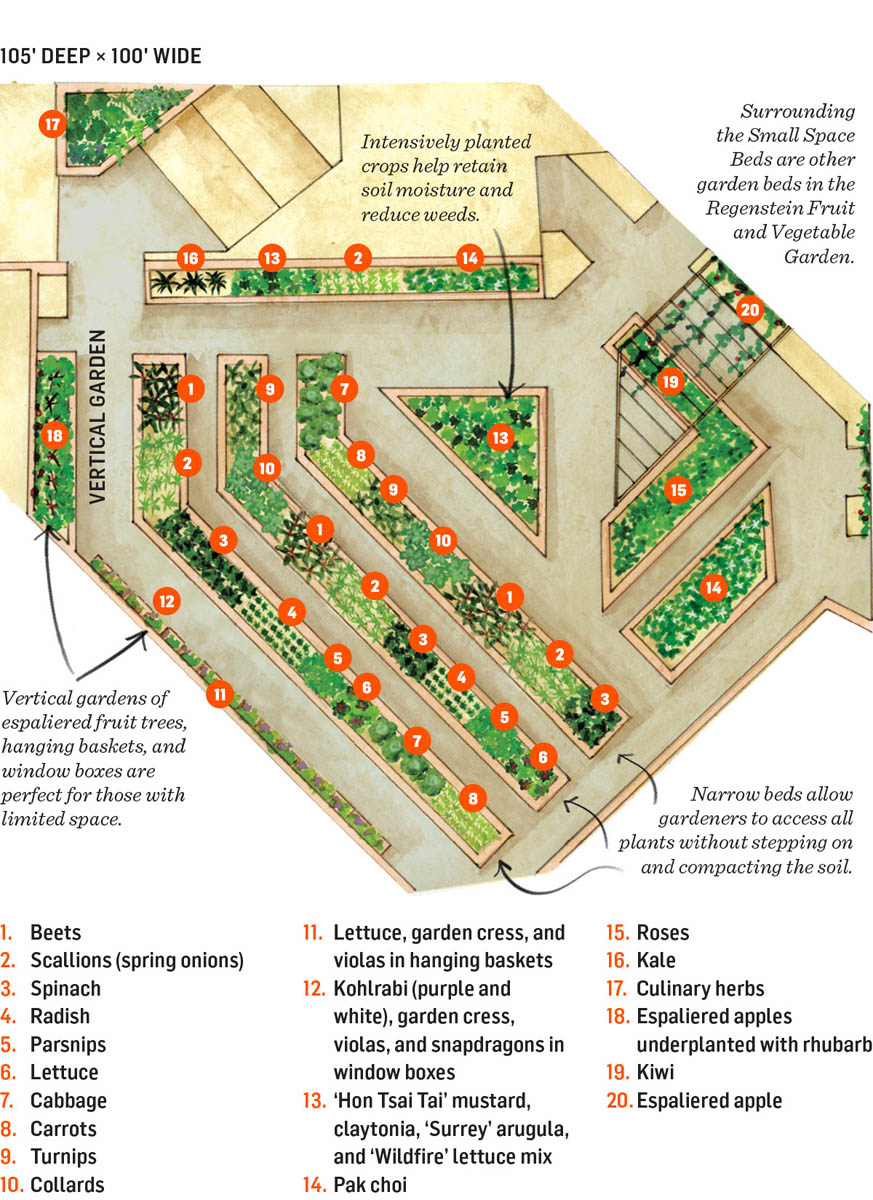
Often described as a “living museum,” the Chicago Botanic Garden occupies 385 acres on and around nine islands and boasts 26 distinct gardens, including the popular Regenstein Fruit and Vegetable Garden, where the Small Space Beds are located. The garden focuses on innovative techniques and ideas for growing more food with less land.
Visitors to the Regenstein Fruit and Vegetable Garden at the Chicago Botanic Garden will enjoy breathtaking scenery and colorful plant combinations as they stroll around the island, but they may be surprised to learn that the focus of this amazing space is on edible, rather than ornamental, plants. A closer look will reveal that the real stars of the show are the hundreds of different types of organically grown vegetable, herb, fruit, berry, and nut plants — most of which are well suited to the Chicago climate.

One of the more popular exhibits is the Small Space Beds. Here, six garden beds make up the prime production area: three long, narrow plots and three smaller geometrically shaped beds. These six gardens are densely planted with plenty of high-producing crops to provide food from spring through late autumn. “The narrow beds allow easy access to all parts of the garden without the gardeners needing to walk on the soil,” says Lisa Hilgenberg, a horticulturist at the Chicago Botanic Garden. “By not walking on the beds, the soil remains loose and well aerated for good root development.”
Learn new gardening methods. Most urban gardeners won’t have enough room to re-create the entire small-space garden, but its style and the methods used to maintain it — such as intensive planting, intercropping, and succession planting — can be transferred to a home garden on a smaller scale. “A big advantage of growing crops intensively is that with thoughtful planning, large amounts of produce can be harvested from a small garden space,” says Lisa, who also points out other advantages to growing crops intensively: soil moisture retention and weed reduction. “With the plants spaced close together, as they fill in and shade the ground, there are fewer weed problems,” she notes.
Experiment with diversity. The Chicago Botanic Garden also uses the Regenstein Fruit and Vegetable Garden to illustrate the diversity found in the vegetable world. For example, gardeners there plant three different varieties of each vegetable to allow visitors to see how each plant responds to the Chicago climate. Diversity is well recognized by organic gardeners as a key to maintaining a healthy plot, and a garden planted with a wide range of vegetables, flowers, and herbs also will draw in more beneficial and pollinating insects, helping to minimize pest populations and ensure good fruit set on crops like cucumbers and zucchini.
Grow up. To grow more food in less space, many crops are grown vertically. Vining crops such as pole beans, grapes, kiwi, and cucumbers are grown up supports. Compact edibles like garden cress, violas, and kohlrabi are planted in pots, window boxes, or hanging baskets. “This garden says, ‘Wherever there is a sunny spot, there’s room for a pot, planter, trough, or garden bed to grow edible plants’ — you can do this at home!” says Lisa.
1. Intensive planting. Minimize wasted space by planting crops close together. Raised beds are a cornerstone of intensive planting and allow you to easily prepare soil and care for closely spaced crops without the need to walk on — and compact — the soil.
2. Interplanting. This technique involves growing two or more vegetables in the same space at the same time. Generally vegetables are matched by maturity times (long versus slow), plant size (tall and upright versus short and spreading) or nutritional needs (heavy versus light feeders).
3. Succession planting. Once a crop has finished, it is immediately pulled and tossed on the compost pile, and the empty space is replanted with fresh seeds or seedlings.

1. Beets: ‘Red Ace’, ‘Kestrel’, and ‘Touchstone’
2. Scallions (spring onions): ‘Nebechan’, ‘Guardsman’, and ‘Deep Purple’
3. Spinach: ‘Space’, ‘Corvair’, and ‘Red Cardinal’
4. Radish: ‘Rudolf’, ‘Crunchy Red’, and ‘Shunkyo Semi-Long’
5. Parsnips: ‘Panache’
6. Lettuce: ‘Rouge Grenobloise’ (‘Red Grenoble’), ‘Merlot’, and ‘Black Seeded Simpson’
7. Cabbage: ‘Caraflex’, ‘Gonzales’, and ‘Savoy Express’ (early varieties)
8. Carrots: ‘Berlicum 2’, ‘Purple Haze’, and ‘Atomic Red’
9. Turnips: ‘Purple Top White Globe’, ‘Tokyo Cross’, and ‘Tokyo Market’
10. Collards: ‘Top Bunch’
13. ‘Hon Tsai Tai’ mustard, claytonia, ‘Surrey’ arugula, and ‘Wildfire’ lettuce mix
14. Pak choi: ‘Win-win Choi’, ‘Mei Qing Choi’, and ‘Joi Choi’
15. Roses: ‘Nyveldt’s White’ hybrid rugosa (2012 Herb of the Year)
16. Kale: ‘Toscano’
17. Culinary herbs: Chervil, chives, sage, salad burnet, parsley, coriander, thyme
11. Lettuce, garden cress, and violas in hanging baskets
12. Kohlrabi (purple and white), garden cress, violas, and snapdragons in window boxes
18. Espaliered apples underplanted with rhubarb: ‘Baldwin’ apples, ‘Canada Red’ rhubarb
19. Kiwi: Hardy ‘Arctic Beauty’
20. Espaliered apple: ‘Wolf River’